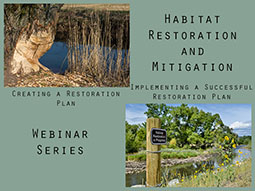|
Description: **This is a download of 6 recorded two-hour webinar sessions. The download includes the full content of the live sessions and the course material bookets in .pdf format.** Course material can be downloaded immediately after payment is made. Registrants will receive a certificate of completion and continuing education units (CEU's) via email approximately 14 days after purchase. Part 1: Creating A Restoration Plan: (6 hours, 3 sessions) Habitat restoration/mitigation programs should address all aspects of a site’s ecosystem, rather than simply enhancing a particular species or group of species. With this in mind, the course material is designed to introduce a complete approach. Attendees will learn to assess site needs, and to create a plan that addresses them using the complete approach. However, since there are times when restoration/mitigation is needed to address specific species, such as special-status or game species which may require specific adaptations, attendees will also learn how to create a species specific restoration/mitigation plan. In addition, attendees will learn the methods of determining debits for impacts and credits for mitigation. An outline for writing restoration/mitigation plans will be presented, which is as “bullet-proof” as possible in terms of providing sufficient information for gaining any necessary approvals and for implementing the plan. Topics covered include determining goals; the background research needs necessary to determine the appropriate type and feasibility of restoration; restoration/mitigation planning processes (soil and hydrology, and planting plan considerations); regulatory and permit consideration; early considerations of unanticipated effects/adaptive management, bioengineering possibilities, best management practices (BMPs), buffers to minimize outside disturbances, climate change considerations, engineering considerations, cost estimations, and a method to determine success criteria. Part 2: Implementing a Successful Restoration Plan: (6 hours, 3 sessions) This webinar provides participants with an overview of the implementation of a successful habitat restoration/mitigation program, and expands to an examination of recommendations for necessary and innovative restoration techniques and monitoring. Attendees will learn the short and long term management techniques of successfully implementing an approved habitat restoration/mitigation program plan. Attendees will also learn the importance of personnel management and involvement. Because everyone involved in implementing habitat restoration plans takes their cues from the project manager, those managers who take a personal interest in the project have a higher success rate of meeting performance standards. Lectures will focus on the varying aspects of habitat restoration implementation, including but not limited to topics such as: logistics, start-up procedures, contract management, bioengineering, vegetation management; early considerations of unanticipated effects with adaptive management procedures, best management practices (BMPs), short- and long-term monitoring, and how to quantify success in terms of ecological structure and function.
Intended Audience: Biologists, landscape architects, planners, and environmental engineers. The course will be designed for those with limited to moderate amounts of experience in natural area management, natural resource management, or in environmental permitting.
Continuing Education Units: 1.20 CEUs
Course Topics
Part 1: Creating a Restoration Plan After completing this course, participants will be able to: · Develop realistic restoration goals · Determine background/baseline conditions for potential restoration/mitigation · Determine regulatory considerations for the planned restoration · Understand restoration planning needs · Determine suitable site conditions and research needs · Understand needs for soil conditioning, hydrology/irrigation needs, and planting plans Part 2: Implementing a Successful Restoration Plan After completing this course, participants will be able to: • Understand the logistics planning required in habitat restoration implementation • Utilize personnel effectively • Understand soil management, irrigation methods, and vegetation management • Understand invasive species management and integrated pest management • Utilize the Best Monitoring Methodologies, and • Understand when adapted management is needed.
About the Instructor
 Larry has been an ecologist for 45 years, with experience in both the public and private sectors. With a M.S. degree in biology from Baylor University, with his thesis researching primary production in east Texas peatlands, his interest through the years has been on the ecological functions of natural systems. He has worked as a natural resources biologist for the Texas Parks and Wildlife Department (park operations), an ecologist for the Alaska Department of Environmental Conservation in coastal management and wetland regulation, and as an ecological consultant in California, Oregon, and Washington. During the fall of 2016, Larry taught an upper level undergraduate class entitled Wetland Ecology, at The University of Montana Western.
Larry has written a number of journal and newsletter articles, and has participated in a number of conferences over the years. He recently published his new e-book, "Creative Habitat Restoration: Comprehensive Planning, Implementation, and Long-Term Management".
Larry has taught courses in habitat restoration in Washington, Oregon, California, Colorado, Texas, and in Vancouver, British Columbia, and has mentored many entry-level biologists in the science of habitat restoration.
What to Bring
This is a download of a recording of a previously presented webinar.
Billing Information
In order to guarantee a space in a course, the tuition must be paid in full TWO WEEKS before the first day of the course by either check or credit card. State and government agencies paying with a purchase order are allowed payment under the two-week time frame if a copy of the purchase order is received by NWETC.
If You Need to Cancel
Cancellations*-
With 31 or more days notice, we will offer a 100% refund or credit towards a future course. The credit is good for one year and may be applied to any course.
- With 30-8 days notice, we will offer a course credit towards a future course. The credit is good for one year and may be applied to any course.
- With fewer than 8 days notice, there is no course credit available
*Please note that attendee replacement is welcome at any time
Disability Accommodations
Disability Accommodations:To request disability accommodations, please contact us at info@nwetc.org or 425-270-3274 at least 30 days prior to the event.
|










